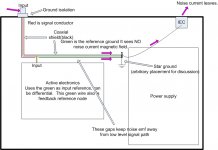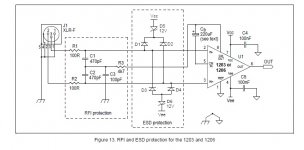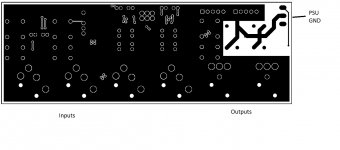GFCI's are pretty cheap. Use them liberally. Even a floating or a grounded transformer source will be safer. Simply put anything over around 10 mA (?) leaving and not returning will trip the GFCI. Simple and effective. On new stuff I would use an arc fault interrupter, one additional layer of protection against dumb or bad things happening.
What's All This Near Field Stuff AnyWay?
I know what it is technically, at the -3dB point from a speaker and forward to the speaker....
Does this only work in a room? Yes?
I've not tried it as any live concerts though. Nor in a small venue, that is a bar or night club.
I do know that as a musician you are only playing in near field unless you are in a medium to large venue.
When's the last time anyone listened to an orchestra in nearfield? And how far back was that from the conductor?
In a room, who want's to be jammed up against their speakers? With a wall in between? Not me, thank you.
For me, I like space. Like 15 - 20 feet between me and TV and speakers. I like the full room sound, with depth. But maybe that is just me. I like rooms with windows I like to see the birds, the
kid, the dog, the grass, the roses, the watermelon's growing, or hoping they are infact growning. Maybe by summers end me and my little girl and eat them.
Now that I think about it, maybe I just like flirting with the
near field...from afar, then move around until I get just right there, but no further.
Maybe my system isn't as good as I think it is.
Then again, when I turn it up, I always use earplugs, especially at clubs. I don't like headaches and I can hear everything just fine with the ear plugs installed. It helps me endure that solid state distortion through various PAs.
Cheers,
I know what it is technically, at the -3dB point from a speaker and forward to the speaker....
Does this only work in a room? Yes?
I've not tried it as any live concerts though. Nor in a small venue, that is a bar or night club.
I do know that as a musician you are only playing in near field unless you are in a medium to large venue.
When's the last time anyone listened to an orchestra in nearfield? And how far back was that from the conductor?
In a room, who want's to be jammed up against their speakers? With a wall in between? Not me, thank you.
For me, I like space. Like 15 - 20 feet between me and TV and speakers. I like the full room sound, with depth. But maybe that is just me. I like rooms with windows I like to see the birds, the
kid, the dog, the grass, the roses, the watermelon's growing, or hoping they are infact growning. Maybe by summers end me and my little girl and eat them.
Now that I think about it, maybe I just like flirting with the
near field...from afar, then move around until I get just right there, but no further.
Maybe my system isn't as good as I think it is.
Then again, when I turn it up, I always use earplugs, especially at clubs. I don't like headaches and I can hear everything just fine with the ear plugs installed. It helps me endure that solid state distortion through various PAs.
Cheers,
Hi Richard, did you get to hear of any dissatisfied customers....ie those who claimed no subjective benefit on their system. If the kinds of systems for this group were known, some data could be drawn perhaps.
Dan.
Hi Dan, I was one who thought it cleaned up the noise floor a bit and made things crisper. I've been using the HTPS7000 MKII. AND, I"ve changed my system around where
I've not taken it out. I've got everything plugged into where it is supposed to be.
I bought a used one that didn't work. I did start a thread about it and both Demian and Richard helped me assess it. I think somebody spilled coffee in it. I eventually took it apart and desolder/cleaned/resoldered the whole damn thing.
Besides some power supply parts and capacitor's after being replaced I still had a burning smell which concerned me. I isolated it to the large ferrite at the input of the unit. I could never find anyone who make or had heard of a #47 Ferrite (if I recall correctly) I cut open the one from the unit. I noticed the wires stank. So I uncoiled them, went to my local wire manufacturing company and they were kind enough to give me replacement wire to use (same gauge) but silver with teflon jacket.
I rewound it with the three new wires, reinstalled it and never smelled the burning smell again. At the time, I thought the OEM wound the ferrites with too much force damaging the insulation leading to breakdown and problems along with the burning odor. Of course it could have been damaged from the original coffee spill causing excess current flow thorough the ferrite before the fuse blew.
I live in a fairly noisy area...with DART trains running by (Like BART, only it is Dallas Area "Rapid" [not] Transit. For what we paid, they calculated they could have bought every Dallasite a BMW and they would still have money left over.
Besides DART there is traffic and general large urban noise of which
Dallas is just about the worst in the U.S.A. I mentioned that to Richard when he asked.
Interesting though when I crank up the stereo loud enough to play along to the music with a guitar and an amp, Blackface or Silverface Fender amp, when I play hard and loud the music will stop and the whatever is connected to the HTPS would have to "reboot" or "restart" again. Same issue before the HTPS also, and I thought it cured it.
Here is the link to my troublshoot and repair of the HTPS 7000 MkII. LINK
Enjoy and Cheers,
Last edited:
The images aren't showing up.
D'oh, serves me right for writing things in the middle of the night.
Attachments
It covers a lot more than distortions, that's just one of the things you can train yourself to hear, so when your 10k hours are up you can hear all sorts. My point was that music theory in too much depth OR actually being a musician can ruin your pleasure. Being able to isolate anomalies in the mix should enhance it. And at least according to Mark you can turn it off and still rock out with earbuds off your phone when required.
Years ago I did a lot of work with video compression. I learned to see all sorts of things whilst poring over all the video data looking for artefacts, which made enjoying stuff difficult. I had to work hard at unlearning it afterwards!
I'm surprised the mods didn't at least comment on the "hot neutral" version of the power-line filter.
Scott
If you are referring to the unbalanced primary / balanced secondary power transformer with the middle point of the secondary grounded, whether single or back to back, you are right.
The original poster made no mention on safety issues (post #5274). It is there that the warning had to be inserted.
It was good that it has been pointed early on by many that the secondary circuit needs fusing and protection by at least a GFCI. (Actually anything past a power transformer that feeds external circuit, is to be treated as a separated derived power system).
The linked FELICIA page on post #5464 has many important notes on safety FELICIA - A DIY Balanced Power Conditioner
Also here
http://espsurgex.com/downloads/white-papers/PowerGround.pdf
http://avocationsystems.com/wp/wp-content/uploads/Ground-Loops-Etc1.pdf
In any case, for each of us as posters, we have to pay attention to Notes 2 and 3
diyAudio Rules
George
Years ago I did a lot of work with video compression. I learned to see all sorts of things whilst poring over all the video data looking for artefacts, which made enjoying stuff difficult. I had to work hard at unlearning it afterwards!
I had a friend who was involved with the design of set top boxes. Apparently this little kids TV character caused some codecs no end of trouble!
I have always been intrigued how CGI that looks great in the cinema looks rubbish on a domestic TV. I suspect it's down the fact that in the cinema the screen is so large that the trick of using focus pull to tell you where to look works and on a 50" at home it doesn't. However my suspension of disbelief is strong enough to overcome that as it's small compared to all the physics fails in the average film these days.
Attachments
Hi Sync.Hi Dan, I was one who thought it cleaned up the noise floor a bit and made things crisper. I've been using the HTPS7000 MKII. AND, I"ve changed my system around where I've not taken it out. I've got everything plugged into where it is supposed to be.
So you haven't done any AB comparison in a long while ?.
Headphones ?.I live in a fairly noisy area...with DART trains running by (Like BART, only it is Dallas Area "Rapid" [not] Transit. For what we paid, they calculated they could have bought every Dallasite a BMW and they would still have money left over.
Besides DART there is traffic and general large urban noise of which
Dallas is just about the worst in the U.S.A. I mentioned that to Richard when he asked.
Where I live is essentially silent, certainly with doors/windows closed.
Huh ?....how loud are you playing your guitar ?.Interesting though when I crank up the stereo loud enough to play along to the music with a guitar and an amp, Blackface or Silverface Fender amp, when I play hard and loud the music will stop and the whatever is connected to the HTPS would have to "reboot" or "restart" again. Same issue before the HTPS also, and I thought it cured it.
Here is the link to my troublshoot and repair of the HTPS 7000 MkII. LINK
Thanks, I have read it through....any chance of PMing the schematic to me ?.
It looks not all that different to the Belkin PureAv filter box equivalent that I had (and didn't like), except no internal isolation transformers.
Dan.
A wire wrapped around another is not a current transformer per se. To get transformer action, the second wire has to wrap around the flux. the flux of the first wire is parallel to the wrapped wires when the wrapped woes are soleniodal.
What I am doing with the long run is wrapping then o the loop area between on average, picks up zero external field. I did this because the venue I was doing had a bazillion watts of old style solid state light dimmers, and noise developed if the line level wire was away from the power cord grounding conductor.
Different twist pitches guaranteed the line cord did not couple to the line level pairs.
Des..I twist the tt rca's with the ground so that external hum and noise does not get into the rca shield as current. It's really only needed if the tt wires are picking something up.
Jn
What I am doing with the long run is wrapping then o the loop area between on average, picks up zero external field. I did this because the venue I was doing had a bazillion watts of old style solid state light dimmers, and noise developed if the line level wire was away from the power cord grounding conductor.
Different twist pitches guaranteed the line cord did not couple to the line level pairs.
Des..I twist the tt rca's with the ground so that external hum and noise does not get into the rca shield as current. It's really only needed if the tt wires are picking something up.
Jn
My solution there was for a system where all metal parts that could be energized must be bonded, a code thing.Ok, so my question on the ground loops.
Attached is one of the diagrams linked earlier from the 2013 discussion on loop areas. The bit that raised my eyebrow on this was 'can be differential'. This just got a bit heavy as it is saying that AES48 is not optimal and there is a better way than pin 1 to chassis, only to chassis, do not pass go, do not collect $200. For a diff and balanced input into an INA this is causing some head hurting.
I then realised that my soon to be (at least as soon as they are boxed) amplifiers use a very similar setup. In this case because it uses the Whitlock THAT input receivers with the full data sheet EMC diodes, so the shield link was necessary.
It still feels wrong though to increase the impedance from shield to ground in a balanced connection. So why is that good and how does that scale when you have >1 input and an output?
I take advantage of the fact that a cylindrical shield has no internal magnetic field caused by the shield current. So, I kept the shield grounding connection to IEC chassis, but figured out how to prevent that current from getting into the signal.
I am not familiar with the Whitlock thing you mention, but had passed this drawing to him in my discussions with him about errors in his presentations, so he may have adopted something I said..who knows,
Ps. In the past, he was always concerned with IR drop and current, but never with current vs loop area induction. It was that coupling I stressed to him.
Jn
Last edited:
The Whitlock thing is this http://www.thatcorp.com/datashts/THAT_1200-Series_Datasheet.pdf in particular the attached RFI and ESD protection. In the power amps I have this is on the amplifier board for practical reasons.
Also attached is the gnd plane from the balanced demo project Bruno Putzys did for his 'G-word' article. This is quite popular with the DIY crowd and seems to work well, plus the design, reasoning and gerbers are all available. In this case all pin 1s are on the ground plane and any direct ground connection is back through the input from the transformer. BUT the XLR used do have a seperate shell connection, so if you have a metal panel then you have a connection there as well. (NC3FAH2 - Neutrik).
So for the case of inputs and outputs is this the optimal method or is there better?
Also attached is the gnd plane from the balanced demo project Bruno Putzys did for his 'G-word' article. This is quite popular with the DIY crowd and seems to work well, plus the design, reasoning and gerbers are all available. In this case all pin 1s are on the ground plane and any direct ground connection is back through the input from the transformer. BUT the XLR used do have a seperate shell connection, so if you have a metal panel then you have a connection there as well. (NC3FAH2 - Neutrik).
So for the case of inputs and outputs is this the optimal method or is there better?
Attachments
Hi Scott,
'cause none of us noticed it.
We try our best to catch things like that, but we are not charged with any sort of technical review. In my experience our members are normally good at catching those things, and sometimes they will report them as dangerous. At that point we will react.
I think Howie covered the safety issues best, but you as well as I know any of these posts could be someone's first view of an idea.
I think Howie covered the safety issues best, ...
Howie clarified the regulatory issues primarily. It was Demian Martin who said to use a GFI. I was the one who initially noticed the problem and kept pointing out that the diagram was mislabeled, as the lower hot leg was not in fact a neutral, and the use of a polarized electrical connector following the transformer for connecting end use equipment would be inappropriate. As far as danger, we are talking about 60 volts mislabeled as a neutral, which could cause a problem but may be less dangerous than what some hobbyists on this website are doing with large arrays of supercapcitors.
The Whitlock thing is this http://www.thatcorp.com/datashts/THAT_1200-Series_Datasheet.pdf in particular the attached RFI and ESD protection. In the power amps I have this is on the amplifier board for practical reasons.
Hey, it's from one of the best, how can it be bad??
My area of concern would be how the shield currents couple to either of the differential lines, or to any circuitry within the amp.
It's great to simply draw a symbol to get the shield currents taken care of, but the devil is in the details of how those currents get from that input connector to the IEC ground . If those currents flow within the chassis metal, does it go past sensitive circuits? As the shield current goes up in frequency, how does the chassis current path constrict? Does it get closer to sensitive stuff or farther?
jn
Last edited:
That's neat, I don't recall seeing an arrangement like thatI take advantage of the fact that a cylindrical shield has no internal magnetic field caused by the shield current. So, I kept the shield grounding connection to IEC chassis, but figured out how to prevent that current from getting into the signal.
we are talking about 60 volts mislabeled as a neutral, which could cause a problem but may be less dangerous than what some hobbyists on this website are doing with large arrays of supercapcitors.
True, the popular Zenith Transoceanic had a hot chassis and a non-polarized two pin wall plug (when not on batteries).
It might not be bad, but it also might not be the best! At the moment still scoping my ignorance in this area. Like, can you get shield currents with double insulated units such as most CD/bluray players. I think the answer is yes, but at exceeding low levels. But I'm probably wrong.
One thing that this all makes me wonder. One of the things with power conditioners is that it forces you to plug everything into the same strip and run the power cables in parallel. Could this reduction in loop area be as big a cause of change as the actual filtering?
Was reading about some of the Hi-Lumi upgrades to CERN over lunch. Retained was
-new big hole in ground
-lots of shiny hogged from solid
-Will take 8 years.
-Great job titles like 'inner triplet magnets engineer'
But I have no idea yet why crabs are needed...
One thing that this all makes me wonder. One of the things with power conditioners is that it forces you to plug everything into the same strip and run the power cables in parallel. Could this reduction in loop area be as big a cause of change as the actual filtering?
Was reading about some of the Hi-Lumi upgrades to CERN over lunch. Retained was
-new big hole in ground
-lots of shiny hogged from solid
-Will take 8 years.
-Great job titles like 'inner triplet magnets engineer'
But I have no idea yet why crabs are needed...
depends if you view a uk ring main as a daisy chain?
For my setup I have one double socket at the hifi end of the room off the ring. Off this I have a 20-way outlet from a production workbench with 10 switched 2 way 13A outlets. Effectively a daisy chain, although not in the sense of 80s receivers where they had switched outlets to power other stuff.
For my setup I have one double socket at the hifi end of the room off the ring. Off this I have a 20-way outlet from a production workbench with 10 switched 2 way 13A outlets. Effectively a daisy chain, although not in the sense of 80s receivers where they had switched outlets to power other stuff.
- Status
- Not open for further replies.
- Home
- Member Areas
- The Lounge
- John Curl's Blowtorch preamplifier part III





